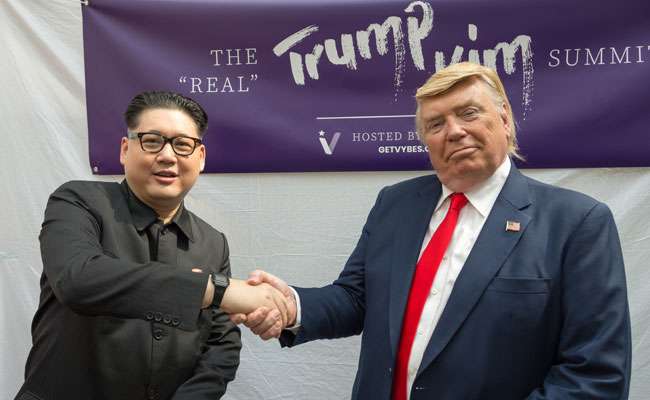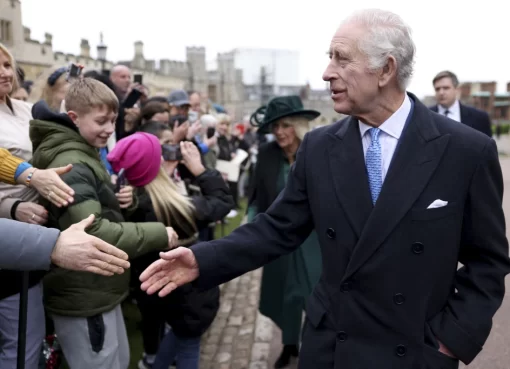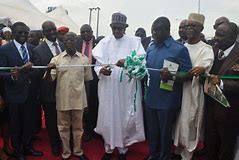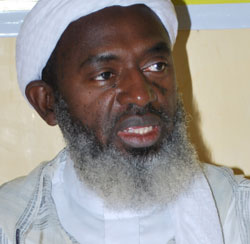Their summit in Singapore on Tuesday — which will begin with a one-on-one meeting, alongside translators — represents an opening awaited for 70 years but that was unthinkable just months ago as they traded insults that sparked fears of a slide into nuclear war.
It could launch a process that could open the world’s last Cold War frontier, finally usher in a permanent peace to end the 1950-53 Korean war, reshape the geopolitics of the Asia-Pacific region and bring millions of North Koreans out of famine and isolation.
Trump arrived in Singapore following a bitter showdown with US allies over his trade tariffs that caused the G7 summit in Canada to break up in acrimony. Secretary of State Mike Pompeo acknowledged on Monday there are strains in relations between the US and its closest allies but was optimistic the relationships would survive.
“There are always irritants in relationships. I am very confident the relationships between our countries — the United States and the G7 countries — will continue to move forward on a strong basis,” Pompeo said while briefing the press in Singapore. Nonetheless, the meltdown potentially raised political pressure on the President to come home from his summit with Kim with some genuine progress.
But if successful, the summit will be mentioned in the same breath as President Richard Nixon’s journey to meet Chinese patriarch Mao Zedong and the superpower talks between Ronald Reagan and Mikhail Gorbachev that precipitated the end of the Soviet Union. But it also represents a massive risk, since a failed summit could short-circuit diplomacy and bring the two countries closer to a disastrous military conflict. Each side enters the talks in a plush resort on Singapore’s Sentosa island expressing optimism.
The official North Korean news agency said Sunday that Kim was ready to talk about “denuclearization” and a “durable peace” at a summit held “for the first time in history under the great attention and expectation of the whole world.” Trump said Saturday that Kim has a “one-time shot” to make history. “I feel that Kim Jong Un wants to do something great for his people,” he said.
The first face-to-face meeting between the leaders of the US and North Korea is the culmination of years of tension, North Korean nuclear and missile tests, and thwarted diplomacy involving the US, South Korea, Japan and China to try to contain the North Korean threat. It brings together a former real estate magnate and reality television star with a ruthless dictator half his age who was once seen as a precocious madman but who has emerged as a shrewd diplomatic operator.
The meeting comes at an auspicious moment: with the US President who says he’s the world’s best dealmaker but seeks a legacy-defining achievement, a popular South Korean President Moon Jae-in who has made dialogue across the DMZ his life’s work, and Kim, who hopes to avoid the grizzly fate of toppled autocrats and to enshrine his rule for decades.
The situation is so urgent now because a blitz of nuclear and missile tests that last year brought the North Koreans close or past the point of capping an intercontinental ballistic missile that could reach the US mainland with a nuclear bomb.
That new reality left Trump facing a fateful choice of taking military action against the rogue nation that could spark a war that could kill thousands, or even millions of people, on the Korean Peninsula, or to launch a daring diplomatic bid to negotiate away the nuclear threat.
Has anything changed?
The long history of failed diplomacy between US administrations and North Korea has many skeptics wondering if anything has changed.
Pompeo noted the checkered history Monday, saying the US “has been fooled before” but the two countries must come together and have “sufficient trust in each other,” to get a deal done. “The United States has been fooled before. There’s no doubt about it. Many presidents previously have signed off on pieces of paper only to find that the North Koreans either didn’t promise what we thought they had or actually reneged on their promises,” Pompeo said.
“We’ll each have to ensure that we do the things, we take the actions necessary to follow through on those commitments and when we do we’ll have a verified deal and if we can get that far we will have a historic change,” he added. In the short-term, the summit offers Kim the prospect of easing biting sanctions. Longer term, it’s possible he could lure US investment to chart a way to greater prosperity for the hermit state while keeping his oppressive rule intact — perhaps on the model of China or Vietnam.
Trump faces the grave responsibility of dealing with a national security threat that could put the lives of tens of millions of Americans at risk. And the summit could be a rare unifying moment in a presidency that is certain to be remembered as one of the most divisive in history. The President has already mused about his chances of winning a Nobel Peace Prize. Eradicating the North Korean nuclear threat would indisputably rank among America’s top diplomatic wins since World War II.
Success in Singapore, twinned with the booming US economy, would also give Trump a strong argument in tough midterm elections. Supporters would cite it as another reason why Robert Mueller’s Russia probe is a massive distraction. The fact the summit is happening at all is a win for Trump, though it likely has more to do with the severe sanctions imposed on North Korea by the administration with buy-in from China than his threats last year to rain “fire and fury” on “Little Rocket Man.” But Kim is also reaping rewards.
His meeting with the US President fulfills one of North Korea’s premier goals — sharing a stage with the world’s top superpower. Such recognition is in itself a de-facto admission that by the United States that Pyongyang merits respect as it is now effectively a nuclear power.
And apart from releasing a trio of US prisoners and staging what most experts believe is a public relations stunt by dismantling a nuclear test site, Kim has offered no meaningful concessions. No one who understands North Korea believes Kim will easily cede his nuclear weapons.
“My own sense is that he would only be ready to (totally disarm) at the end of a very long process and that his goal at the present time is to remain a de facto nuclear power while reducing the sense of worry and threat about that so he can begin to develop the economy,” said Kathleen Stephens, a former US ambassador to South Korea. “I do think he is very serious about wanting to make North Korea a more normal country, looking more like its neighbors, more like a successful Asian economy,” said Stephens, now with the Freeman Spogli Institute at Stanford University.
Much will rest on whether Kim has made a strategic choice to use his nuclear arsenal as leverage in return for security guarantees and investment from the United States or whether North Korea is playing a familiar game of demanding concessions for pseudo disarmament.
Many analysts point out that nukes are Kim’s ultimate safety net and any deal with the US would require intrusive inspections by foreign assessment teams over a period of years that he may find impossible to accept. “Every statement, every utterance from Kim Jong Un has not even conveyed a hint of his inclination to denuclearize,” said Evans Revere, a former senior State Department official with long experience of negotiating with North Korea. But Revere added that there was some reason for hope.
“The North Koreans, for various reasons, are closer to being willing to freeze or even give up their program than they have ever been, and that is not a bad thing,” he said. Huge gaps remain between the sides, however. North Korea sees denuclearization as entailing the exit of US troops from the peninsula and the withdrawal of the US nuclear umbrella for South Korea and Japan.
Kim has also called for a “phased and synchronous” approach to disarmament — code for financial concessions from the US and its allies for reciprocal steps from the North. The Trump administration initially opposed that approach, which failed for previous White Houses and demanded swift, comprehensive and irreversible denuclearization. But after meeting North Korea’s senior envoy Kim Yong Chol at the White House earlier this month, Trump showed signs of flexibility.
“We’re not going to go in and sign something on June 12 and we never were. We’re going to start a process,” Trump said.
The worst-case scenario is that the summit becomes little more than a photo-op that fails to kickstart a viable diplomatic process. The best outcome may be a joint statement that calls for denuclearization and future US security guarantees for North Korea and the eventual normalization of relations.
Both sides could offer to take confidence-building steps as signs of good faith. Trump has said he could possibly invite Kim to the US, and it’s also possible Kim could invite the US President to make a historic journey to Pyongyang. But it will be impossible to truly evaluate the success of the summit for months or years to come.






